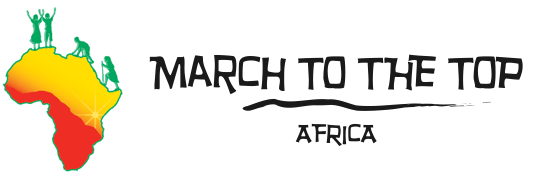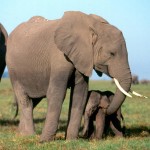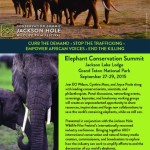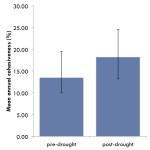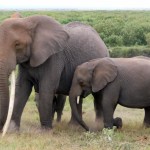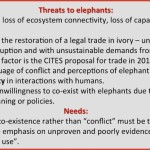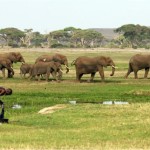BLOG
News from the Amboseli Trust for Elephants
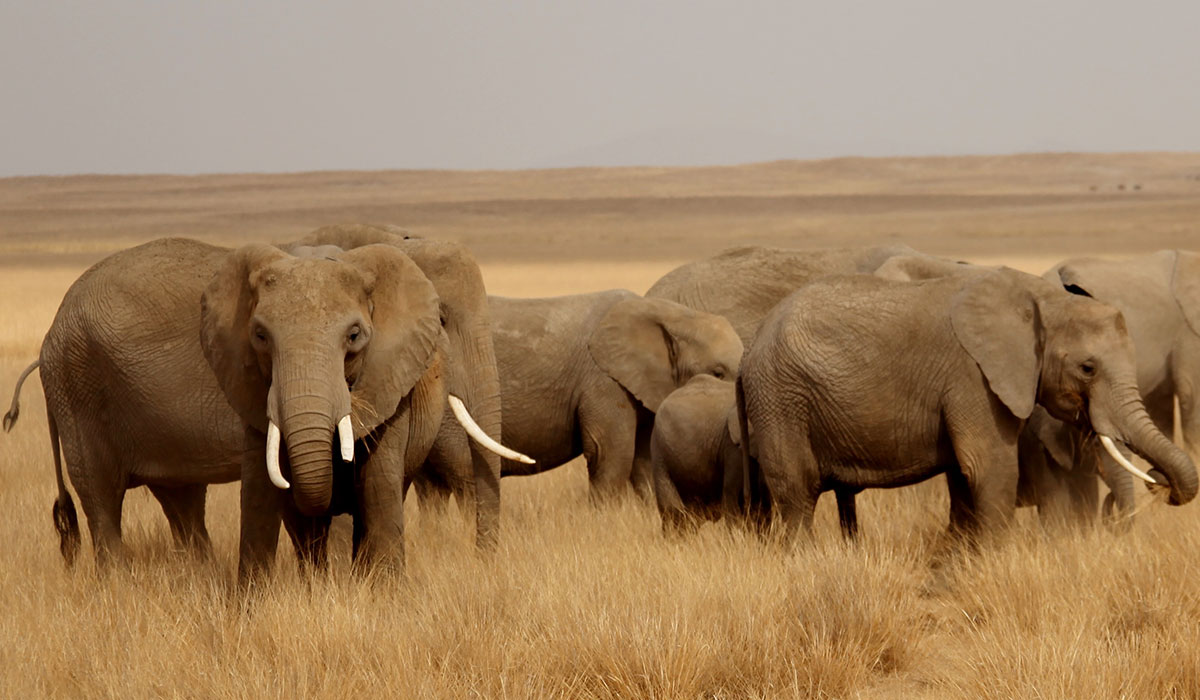
July and August is the time of year for academic conferences and this year two ATE scientists presented findings at two different meetings. Phyllis Lee attended the 27th International Congress for Conservation Biology in Montpellier, France and Vicki Fishlock flew 30 hours to Cairns in Australia to give a paper at the Behaviour 2015 conference, a joint meeting of the International Ethological Conference and three Australasian societies for the study of animal behaviour. The two papers are summarized in the first two articles below.
So often in this newsletter we write about our conservation or advocacy work or about the amazing behavior of elephants, and so it might be possible to forget that we are also the Amboseli Elephant Research Project and we are very proud of our science. Much of what we know today about wild, free-ranging elephants has been discovered in Amboseli.
We will soon be celebrating 43 years of research on the Amboseli population. There are very few long-term studies like this and we know we have been extraordinarily fortunate and privileged to have carried on this remarkable, unbroken research for such a long time. We have no plans to stop. After all, we haven’t even watched these elephants for a single life span. I know there will be many more exciting discoveries over the next years.
I also know we couldn’t do our work without the support of donors. I hope you know how important you are to us and the elephants.
Cynthia Moss
Director
Amboseli Trust for Elephants
Conservation Biology Conference in Montpellier: presentation by Phyllis Lee
Elephants in human landscapes: behavioural and social responses to risk
P.C. Lee, M. Sowers, V. Fishlock, H. Croze, K. Kangwana, W.K. Lindsay & C.J. Moss
01
Amboseli elephants have always lived alongside their Maasai neighbours in their ecosystem. At times the Maasai and their livestock represent a risk to elephants, by excluding them from water or food, or by spearing elephants. At other times, they co-exist peacefully side by side. Both males and females respond to a perception of risk due to their encounters with humans by avoiding direct interactions around settlements, by waiting to use resources such as water until after people or livestock have left, or by forming groups of large size.
Over the past 20 years, the elephants have started to use more of the ecosystem, travelling across the space through safe corridors. These corridors and an undivided, unfenced ecosystem are now absolutely essential to the sustainability of the Amboseli elephant population.
Threats to elephants globally are rising intolerance due to lack of space – emphasising the important of corridors for our elephants. In addition renewed discussion for a legal trade in ivory place every elephant in Africa at threat.
02
Behaviour Conference in Australia: talk by Vicki Fishlock
Chaos and cohesion: social disruption and leadership loss in elephant families
V. Fishlock, P.C. Lee & C.J Moss
Every two years the International Ethological Conference brings together biologists studying animal behavior across the globe in almost every imaginable species. This year’s conference was held in beautiful Cairns, next to the Great Barrier Reef.
Truthfully, elephants are not an ideal study species – their lives unfold so slowly that it often takes a long time to gather enough data to answer research questions. But they are very important to understand because they lie towards the “long-lived, slow growing, socially complex” end of the animal life spectrum (think of mice and fruit flies at the other end). Of course they are also keystone species (they have huge effects on the ecosystems they occupy) and an umbrella species (protecting elephants and meeting their complex needs has knock-on benefits for more cryptic species).
Forty-nine year old Theodora is one of Amboseli’s magnificent matriarchs who survived the horrific 2009 drought.
Forty-nine year old Theodora is one of Amboseli’s magnificent matriarchs who survived the horrific 2009 drought.
Our Social Disruption Study, supported by IFAW, investigates the resilience and recovery of the Amboseli elephant families after a devastating drought. Older, experienced female leaders are important sources of knowledge and buffer risks for their families. Understanding this is important for predicting how populations less fortunate than Amboseli might recover after the devastation poachers wreak. In 2008-09 30% of the elephant population died, including 55% of females over the age of 35, and 89% of females over the age of 50. Twenty-one matriarchs died, whose mean tenure as leaders was 21.6 years (max. 39.8 years). These losses represent a huge change in the decision-making structure of elephant families.
Post-drought recovery has been good; the “baby boom” of 2011-12 gave us a huge new calf cohort, amongst whom survival has been the highest ever recorded. However, we are also seeing subtle effects, with drought survivors spending more time together and females having slightly lengthened interbirth intervals (see graphs). Elephants are remarkably resilient and given safety and enough space they can recover from massive harmful events.
We build complex statistical models that allow us to examine the effects of the drought, while allowing for other factors that affect the variables we are measuring (e.g. ecological conditions, family size, matriarch age). Here we show that cohesiveness (the amount of time all family members are together) and interbirth intervals both increase amongst drought survivors.
We build complex statistical models that allow us to examine the effects of the drought, while allowing for other factors that affect the variables we are measuring (e.g. ecological conditions, family size, matriarch age). Here we show that cohesiveness (the amount of time all family members are together) and interbirth intervals both increase amongst drought survivors.
Elephant Summit in Jackson Hole
Cynthia Moss, Joyce Poole and Iain Douglas-Hamilton are being honoured with Outstanding Achievement Awards at the Jackson Hole Wildlife Film Festival. As part of the Festival there will be a three-day Elephant Conservation Summit with top experts on elephants and the illegal ivory trade.
05
Amboseli Book Chapter Summary, 21
Ethical Approaches to Elephant Conservation
by Joyce H. Poole, W. Keith Lindsay, Phyllis C. Lee, and Cynthia J. Moss
Gwen allomothering her newborn sister.
Gwen allomothering her newborn sister.
Much of the ethical debate on the treatment of animals revolves around questions of individual suffering and whether individual elephants have any rights in a human-dominated world. Elephants have aesthetic and traditional value in the human domain, and their ecological and biodiversity value as biological entities is often overlooked. They are sentient creatures. Do we have the right to impose our human value system on elephants, to control and manage them as we see fit? In a broader sense, reflecting upon our attitudes toward elephants leads us to question our approach to “dominion” over the world’s resources and all its species. How heavy or light will the human footprint become as we develop an awareness of our collective impact on the planet’s vital processes? The answer to these questions essentially determines how we will treat elephants-with either the respect they deserve or continued exploitation.
Elephants are intelligent and highly social and experience a wide variety of emotions and feelings, displaying qualities found only in cetaceans and higher primates. It is past time to accept that our treatment of elephants should be based on careful consideration of alternatives. In developing creative solutions to challenging problems, ethical concerns rather than simple expediency and narrow, self- serving human interests should be paramount.
This chapter covers ATE’s views on the following:
The Commercial Exploitation of Elephants including ivory trade, trophy hunting and the capture of calves
The Needs of People, including land use policies and human-elephant interactions
Local High Elephant Densities, including the use of contraception, translocation and culling
The more we know about elephant lives, the more we get a sense of their complexity and individuality. As we get to know them better, we appreciate more of the subtleties that govern elephant society, and lead us into fresh research questions. Understanding individuals underpins our approach to both science and advocacy and we continue to develop both areas of our work to fight for elephants for the future they deserve: wild, free, forever.
Cynthia Moss
Director
